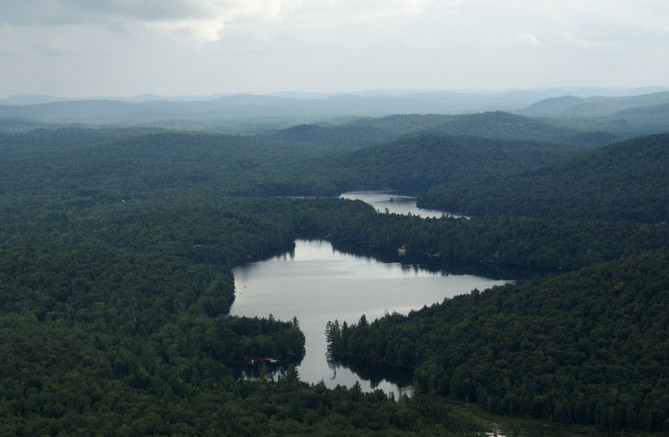The Adirondack Park State Land Master Plan (SLMP) sets policy for the management of state owned lands. Developed by the Adirondack Park Agency in cooperation with the Department of Environmental Conservation (DEC) and approved by the Governor of New York State, the Master Plan was first adopted in 1972. The actual management of the State Lands is carried out by DEC forest rangers, foresters, environmental conservation officers, and other state personnel.
State Land Classification
State land is classified into the following seven categories according to the Adirondack Park State Land Master Plan.
Wilderness:
A wilderness area, in contrast with those areas where man and his own works dominate the landscape, is an area where the earth and its community of life are untrammeled by man–where man himself is a visitor who does not remain. A wilderness area is further defined to mean an area of state land or water having a primeval character, without significant improvement or permanent human habitation, which is protected and managed so as to preserve, enhance and restore, where necessary, its natural conditions, and which (1) generally appears to have been affected primarily by the forces of nature, with the imprint of man’s work substantially unnoticeable; (2) has outstanding opportunities for solitude or a primitive and unconfined type of recreation; (3) has at least ten thousand acres of contiguous land and water or is of sufficient size and character as to make practicable its preservation and use in an unimpaired condition; and (4) may also contain ecological, geological or other features of scientific, educational, scenic or historical value.
Primitive:
A primitive area is an area of land or water that is either:
1. Essentially wilderness in character but, (a) contains structures, improvements, or uses that are inconsistent with wilderness, as defined, and whose removal, though a long term objective, cannot be provided for by a fixed deadline, and/or, (b) contains, or is contiguous to, private lands that are of a size and influence to prevent wilderness designation; or,
2. Of a size and character not meeting wilderness standards, but where the fragility of the resource or other factors require wilderness management.
Canoe
A canoe area is an area where the watercourses or the number and proximity of lakes and ponds make possible a remote and unconfined type of water-oriented recreation in an essentially wilderness setting.
Wild Forest:
A wild forest area is an area where the resources permit a somewhat higher degree of human use than in wilderness, primitive or canoe areas, while retaining an essentially wild character. A wild forest area is further defined as an area that frequently lacks the sense of remoteness of wilderness, primitive or canoe areas and that permits a wide variety of outdoor recreation.
Intensive Use:
An intensive use area is an area where the state provides facilities for intensive forms of outdoor recreation by the public. Two types of intensive use areas are defined by this plan: campground and day use areas.
Historic:
Historic areas are locations of buildings, structures or sites owned by the state (other than the Adirondack Forest Preserve itself) that are significant in the history, architecture, archeology or culture of the Adirondack Park, the state or the nation; that fall into one of the following categories;
- state historic sites
- properties listed on the National Register of Historic Places
- properties recommended for nomination by the Committee on Registers of the New York State Board For Historic Preservation; and that are of a scale, character and location appropriate for designation as an historic area under this master plan and the state has committed resources to manage such areas primarily for historic objectives
State Administrative:
State administrative areas are areas where the state provides facilities for a variety of specific state purposes that are not primarily designed to accommodate visitors to the Park.
Learn more at http://apa.ny.gov/State_Land/index.html




